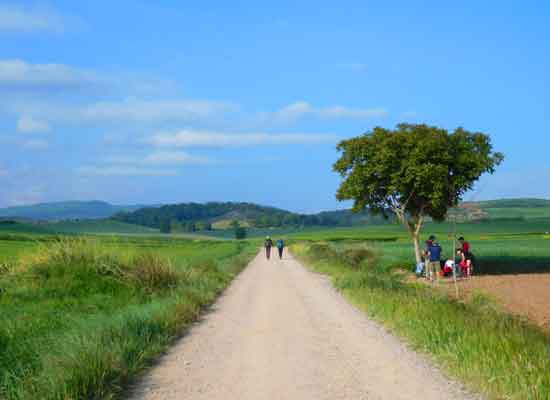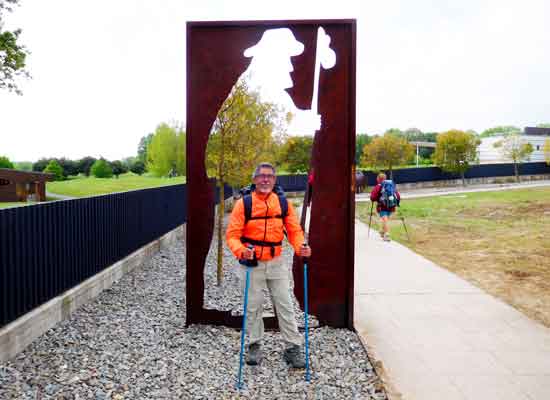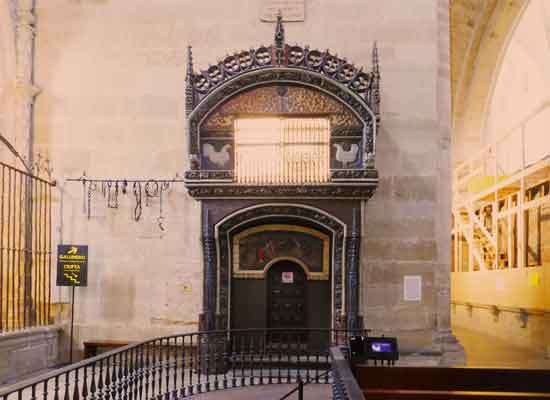Step by step along The Way of Saint James
From Nájera to Santo Domingo de la Calzada
19 May 2018
Stage 9 – Km. 21

In the large, communal dormitory of the municipal hostel in Nájera, there is movement from the “madrugada” (a Spanish term referring to the hours before “el amanecer,” or sunrise).
A true pilgrim begins their walking day while it is still dark, using a flashlight to illuminate the path.
Despite the large number of pilgrims sharing the same space, the night passed without too much disturbance. During the night, the bunk bed next to mine became vacant, and whoever had been occupying it relocated elsewhere; I did not inquire about this and cannot say what the reason was, though it’s easy to imagine.
Today, I start my walk at 6:30.
By the end of the day, I will reach Santo Domingo de la Calzada, considered the most interesting destination in La Rioja.
The route to get there is not particularly challenging: the elevation change is negligible, and the length—just under 21 kilometers—is below the daily average.
The only difficulty is that this stage takes place entirely in an area without shade. Fortunately, today there are several clouds, so I shouldn’t have the problem of baking under the sun during the walk. The temperature also remains fairly low.
Leaving Nájera, the route climbs gently onto the rocky outcrop overlooking the town: the red of the rocks and the green of the vegetation are the dominant colors of the landscape.
Soon the incline levels out, and vineyards reappear, occasionally giving way to some wheat fields.
Shortly before eight o’clock, I reach Azofra, the only village along this stage. I stop here briefly to eat something and refill my water supply, as there will be little else along the way.
The main attraction in Azofra, situated on a small hill, is the Iglesia de Nuestra Señora de los Ángeles, which dates back to the 18th century.
It’s yet another church I visit, and like all the others I’ve encountered so far, I don’t miss the chance to photograph it.
In most small villages, the church is the only historical building of interest. Therefore, to preserve a memory of these places, the only distinctive element I can photograph is the sacred building itself.
By the end of my pilgrimage, I will have a complete collection of all the churches along The Way of Saint James.

After Azofra, I walk for nearly two hours without encountering anything else.
As I tread the dirt path, I see only green fields and gentle hills stretching out as far as the eye can see.
Lost in my thoughts, my shadow keeps me company. As always, it stays ahead of me, pointing westward and reassuring me that I’m heading in the right direction.
I have lost sight of Rocco and Dante, and now I’m not sure whether they’ve gone ahead or lagged behind. But this isn’t a problem, as we will meet up somewhere eventually—worst case, at the end of the stage.
By now, it has become a habit for the three of us to plan our days together, without compromising the freedom to experience The Way at our own pace and according to our own interests.
Most of the time, I’m the one who falls behind—I often stop to take photos or follow small detours to see points of interest.
Today, we’re considering extending the stage to Grañón, a small village six kilometers beyond Santo Domingo de la Calzada. For now, it’s just an idea, and we’ll decide later whether to adjust today’s plan.
The interest in Grañón stems from the special hospitality offered by the parish priest, Jesús García, at the Iglesia de San Juan Bautista.
In an atmosphere of peace and harmony, everyone dines together, and at the end of the evening, there is a moment of sharing.
Sleeping arrangements are in the thousand-year-old bell tower, where there are about forty beds. This number isn’t fixed and can increase without limit because no one is turned away—a space is always found. If needed, even the church itself can be used.
Breakfast is provided in the morning, also shared among all the pilgrims.
When leaving, a “donativo” is offered at one’s discretion by placing the money directly in a box.
After about eight kilometers of walking through emptiness, there’s a small stall set up at the side of the path by a young man. Pilgrims can find water, coffee, and fruit here, along with small items featuring symbols of The Way of Saint James, such as pins, shells, and more.
You can take whatever you need, and in return, you express gratitude with a “donativo.”
The “donativo” is a voluntary cash offering, calculated personally by each pilgrim.
This approach is common along The Way, practiced by both individuals supporting travelers and some municipal hostels.
In these cases, the people running these services are volunteers who also have expenses to cover. Therefore, those who use their services are free to leave an appropriate amount, ensuring that future pilgrims can find the same support.


***
Around half past ten, I pass through Cirueña, a small and fairly insignificant village that attracts tourists more for its modern golf course than for pilgrimage purposes. Nevertheless, the streets of the village are adorned with symbols of The Way—scallop shells and representations of past pilgrims displayed in large, modern iron installations.
After Cirueña, there are still six kilometers left to reach Santo Domingo de la Calzada.
I find the landscape I’m walking through particularly evocative.
The dirt path I follow, straight as a ruler, cuts through vast fields of cereals. The varying shades of green, interspersed with bright yellow patches from the rapeseed flowers, create a striking contrast.
The sweeping 180-degree view gives me the impression of looking at the land from an airplane rather than standing on the ground.
With just a few kilometers left to Santo Domingo de la Calzada, I catch up with Rocco, and with him is Dante—the man with the carted backpack that he pulls by hand. From here, we continue walking together and once again consider whether to extend today’s stage to Grañón.
Around midday, we arrive in Santo Domingo de la Calzada.
A directional arrow in front of a shop informs us that there are 562 kilometers left to Santiago.
Reaching the square with the cathedral, we sit down on a step and have a mid-day snack.
After resting for a good half hour, we lose our motivation to continue walking and cover the six kilometers to Grañón.
– That’s what happens when you stop for too long—it’s hard to get going again! –
Moreover, the hostel is just a few steps from the square, and we feel its pull as strongly as Ulysses did with the sirens—except we are not tied to any mast and are free to conclude today’s “Odyssey” right here.


After settling in at the Albergue Cofradía del Santo, we spend the afternoon exploring the fascinating historic center of Santo Domingo de la Calzada.
We start with a visit to the cathedral, where pilgrims are offered a discounted entrance ticket for 4 Euros.
The three-nave church features Romanesque-Gothic architecture and was founded in the 12th century, with various additions made over time.
The main exterior façade displays semicircular arches, round windows, and three niches, each containing a statue. The central sculpture represents the saint to whom both the church and the town are dedicated.
The grand retablo of the main altar, made of alabaster and walnut, is particularly impressive.
In the right transept, there is the tomb of Saint Dominic the Hermit, along with his statue.
The richly decorated chapels scattered throughout the church also deserve attention.
However, the most unique and curious feature that draws visitors is the presence of a “henhouse” inside the cathedral—a cage containing two live chickens, which are replaced every two weeks.
Their presence in the church is linked to a legend. It tells the story of a boy who was sentenced to death but miraculously survived his hanging, thanks to Saint Dominic or Saint James, depending on the version.
The magistrate who had sentenced the young man was informed of the miracle while sitting at his table for lunch.
Upon hearing the news, the judge laughed heartily, claiming that the boy was as dead as the two roasted chickens he had on his plate.
No sooner had he finished speaking than the chickens sprang back to life, feathers and all, and began to crow.
To conclude our visit, we explore a small museum attached to the church.
Next, we climb the cathedral’s detached bell tower, located on another side of the square.
We access the belfry by ascending 132 steps on foot.
From the top, the panoramic view isn’t particularly striking, but the 360-degree perspective still evokes a sense of wonder.
Looking back, I have to say that Santo Domingo de la Calzada is worth a long and thorough visit—not a rushed one, as it would have been had we decided to sleep in Grañón.
After feeding our minds with culture, we now focus on feeding our bodies. We head out to shop for dinner, which we will prepare this evening at the hostel.
This time, we keep it simple to avoid spending too much time cooking—pre-made salad, chicken breast, beers, and as a final treat, a good “packaged” ice cream.
After shopping, I head out for an aperitif with Paolo, the man from Bergamo.
We go to the Plaza de España, the town’s main square, located behind the cathedral and overlooked by the 18th-century town hall.
We sit at the outdoor tables of a bar, joined by two lovely French women who are walking The Way of Saint James together.
What’s unique about this duo is that they are mother and daughter—remarkably, the mother keeps up with her daughter, not just in walking but in everything they do.
We accompany our beers with casual conversation, switching between French, English, and Italian.
After a while, two Spanish pilgrims join us. I don’t know them personally, but they are friends of the two women. So, we add Spanish to our multilingual chat.
– That’s The Way for you! An endless web of relationships and acquaintances that multiply constantly, sometimes exponentially. –
Meanwhile, Rocco and Dante, who have been waiting for me to have dinner and have heard nothing from me, start preparing food, trusting that I will eventually show up.
When I finally arrive at the hostel, everything is ready, and all that’s left for me to do is sit down and eat.
| © Aldo Lardizzone 2020 |  |
CREATIVE COMMONS |



